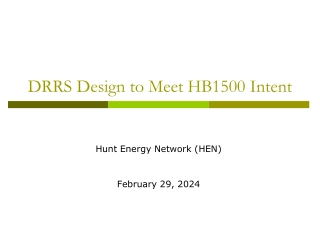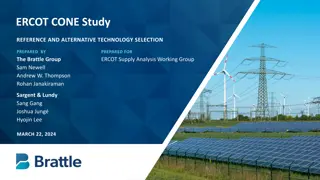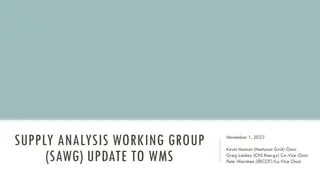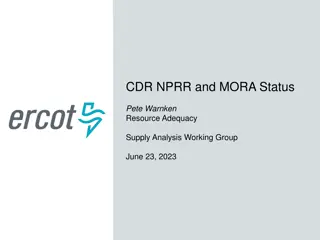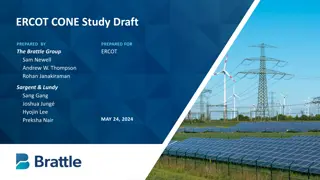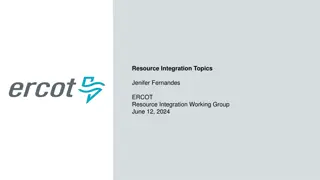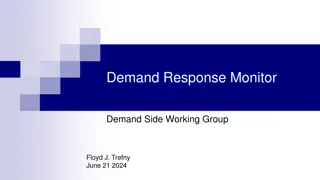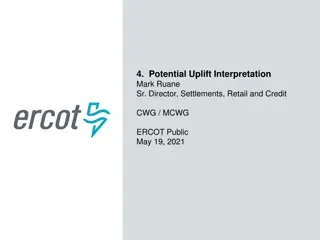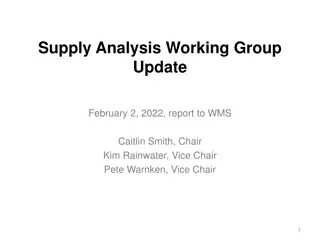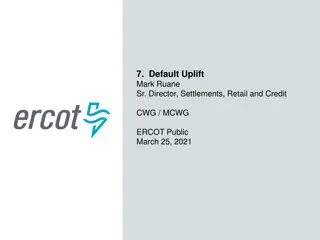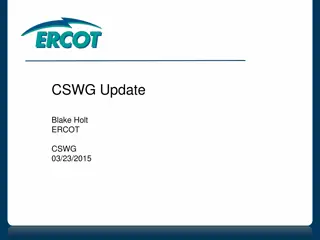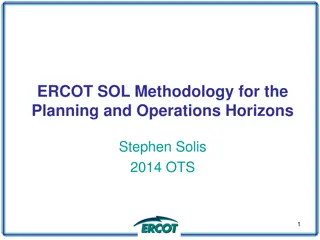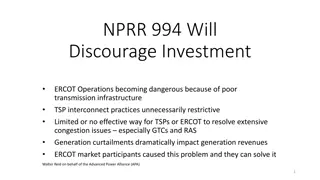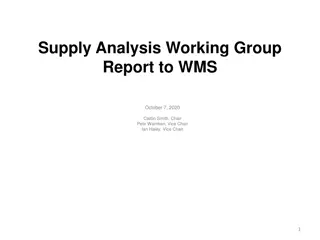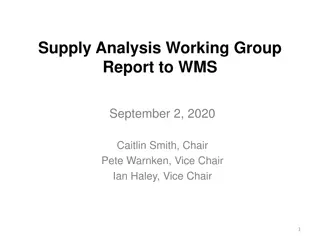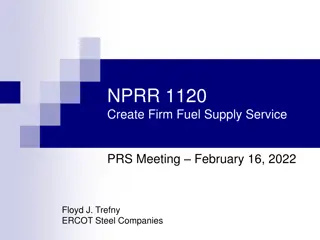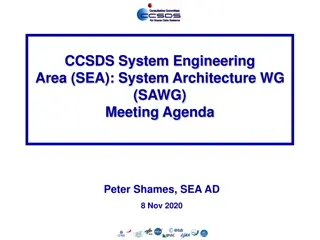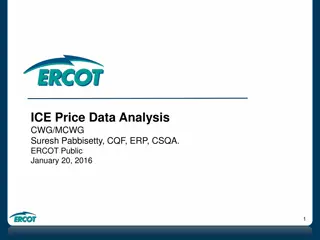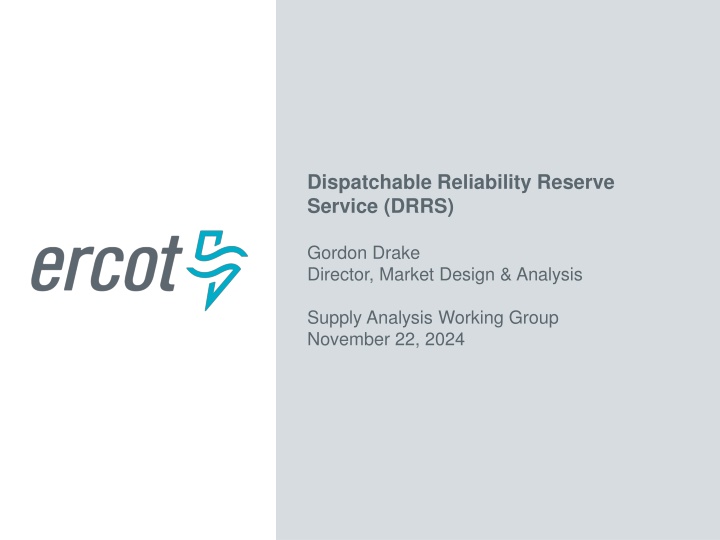
Development of Dispatchable Reliability Reserve Service (DRRS)
The Dispatchable Reliability Reserve Service (DRRS) is being developed in response to regulatory requirements to procure reliability reserve services in ERCOT. The genesis, design attributes, and operational implications of DRRS are discussed, including its standalone nature, eligibility criteria, and evolving role in ensuring grid reliability. Stakeholder feedback and debates on DRRS's role as an operational tool or resource adequacy mechanism are highlighted.
Download Presentation

Please find below an Image/Link to download the presentation.
The content on the website is provided AS IS for your information and personal use only. It may not be sold, licensed, or shared on other websites without obtaining consent from the author. If you encounter any issues during the download, it is possible that the publisher has removed the file from their server.
You are allowed to download the files provided on this website for personal or commercial use, subject to the condition that they are used lawfully. All files are the property of their respective owners.
The content on the website is provided AS IS for your information and personal use only. It may not be sold, licensed, or shared on other websites without obtaining consent from the author.
E N D
Presentation Transcript
Dispatchable Reliability Reserve Service (DRRS) Gordon Drake Director, Market Design & Analysis Supply Analysis Working Group November 22, 2024
Genesis of DRRS The impetus for developing DRRS comes from PURA 39.159 (d) and (e): (d) The commission shall require the independent organization certified under Section 39.151 for the ERCOT power region to develop and implement an ancillary services program to procure dispatchable reliability reserve services on a day-ahead and real-time basis to account for market uncertainty. Under the required program, the independent organization shall: (1) determine the quantity of services necessary based on historical variations in generation availability for each season based on a targeted reliability standard or goal, including intermittency of non-dispatchable generation facilities and forced outage rates, for dispatchable generation facilities; (2) develop criteria for resource participation that require a resource to: (A) be capable of running for at least four hours at the resource's high sustained limit; (B) be online and dispatchable not more than two hours after being called on for deployment; and (C) have the dispatchable flexibility to address inter-hour operational challenges; and (3) reduce the amount of reliability unit commitment by the amount of dispatchable reliability reserve services procured under this section. 2 PUBLIC
DRRS Design to Date Through 2024, ERCOT and stakeholders have been developing the concept of DRRS as an Ancillary Service. The key attributes of this approach have been: DRRS will be a standalone Ancillary Service, not a subtype of another existing Ancillary Service such as Non-Spin DRRS will be designed to meet operational needs around forecast uncertainty on both the supply-side and demand-side Eligibility will be initially limited to Off-Line dispatchable Resources that can start within 2 hours and operate at their High Sustained Limit (HSL) for at least 4 hours, with consideration of Energy Storage Resources (ESRs) being taken up in a distinct design effort Controllable Load Resources will not be eligible to provide DRRS NPRR1235 has been the primary vehicle for specifying how these attributes and other design elements will be incorporated in the Protocols 3 PUBLIC
Operational tool? Or resource adequacy mechanism? In August, Luminant presented to SAWG that DRRS should be explicitly linked to achieving the Reliability Standard approved by the PUCT. This was followed by formal comments from Luminant in advance of the September SAWG meeting. This proposed approach was met with a mix of support and opposition from stakeholders. Both the IMM and ERCOT expressed concerns about the approach, particularly from the perspective of price formation as well as the genesis of DRRS as an operational uncertainty tool. As part of the PUCT Ancillary Services Study, the PUCT invited comments on the role of DRRS and how to address concerns about price formation. DRRS was discussed at length at the 10/31 PUC workshop on the AS Study. Commenters were split on the topic of whether DRRS was intended to be a resource adequacy tool and the consequences thereof. PUCT Staff 4 PUBLIC
PUCT Staff recommendations provide guidance Staff has reviewed the comments regarding the role of DRRS as a resource adequacy tool and recommends that the Commission not grant it a special status for this purpose. ... designating DRRS as a resource adequacy tool is not necessary to use it for resource adequacy purposes, though, making such a designation could lead to misunderstandings. To the extent that the Commission seeks to further incentivize dispatchable generation, changes to DRRS procurement design could be one of the many options available. Staff recommends that present design efforts not be diverted to also design DRRS to meet some resource adequacy goal. Changes to the design are always available for future consideration. 5 PUBLIC
In the long-term, there is uncertainty The difference between an operational tool and resource adequacy tool largely come down to the quantity procured At larger quantities under the NPRR1235 design, ERCOT and others become very concerned about the potential impact to price formation A design that is future- proofed for both use cases is appropriate Resource Adequacy Operational Risks 6 PUBLIC
Concept 1 Multiple pass option Procured in both DAM and Real-Time, using the same demand curves A key attribute of this concept is that following procurement, the quantities of DRRS are made available to SCED for dispatch and not withheld Eligibility On-line and Off-line Resources that are: Dispatchable by SCED If Off-line, capable of starting within 2 hours Able to sustain their HSL for at least 4 hours May require certain ramping characteristics as part of qualification process to satisfy inter-hour requirements 7 PUBLIC
Concept 1 (contd) DAM Mechanics DAM participation is voluntary QSEs have the option to offer energy and AS (including DRRS) and be paid if awarded DAM will be performed in two passes (most likely in series) Pass 1 is a simplified DAM optimization targeting DRRS procurement Pass 2 is the classic DAM optimization with some additional limitations to reflect Pass 1 DRRS commitment 8 PUBLIC
Concept 1 (contd) DAM Pass 1 Inputs Energy Offers/Bids, AS Offers (including DRRS) Virtual Energy/AS Offers Load forecast by zone with proxy Load Zone Energy bids DAM co-optimizes Energy and AS for all hours, without considering network constraints (to reduce runtime) Binding outputs DRRS MCPC DRRS award to Off-line resources Off-Line Resources will update COP status to DRRS 9 PUBLIC
Concept 1 (contd) DAM Pass 2 Largely the same as today s classic DAM optimization Outputs from Pass 1 may be enforced in Pass 2 to drive appropriate commitment decisions The quantity eligible for DRRS payment will be an output of this pass In the pass, On-Line resources awarded DRRS are not withheld from SCED but can be economically dispatched 10 PUBLIC
Concept 1 (contd) Real-Time Procurement To achieve the required reduction in RUC commitments, a process must run ahead of RUC to procure DRRS in real-time while respecting the operating characteristics of DRRS-eligible Resources This process will run 4 hours ahead of the Operating Hour and procure DRRS only for that Operating Hour Allows Off-line >2 hour lead time Resources to be procured and deployed as alternative to RUC, if needed Binding outputs DRRS MCPC Quantity eligible for DRRS payment DRRS awards to Off-Line resources 11 PUBLIC
Concept 1 (contd) Real-Time Procurement and RUC Once awarded DRRS, an Off-line Resource will update its COP status to DRRS for the target Operating Hour An Off-Line Resource carrying DRRS may choose to self-commit Otherwise, RUC will prioritize committing an Off-Line Resource with a DRRS COP status before one with an OFF COP status Real-Time scheduling RTC-SCED runs as normal No constraints applied based on DRRS Resources awarded DRRS are not withheld from SCED but can be economically dispatched and/or awarded other AS 12 PUBLIC
Concept 1 (contd) Benefits Meets the statutory requirements in PURA 39.159 Targets all dispatchable Resources and overcomes difficulties for On-line Resources and Energy Storage Resources in NPRR1235 design Value of DRRS will scale with the quantities procured, however Real-Time energy prices will be protected from upward pressure of withholding procured DRRS MW, ensuring that non-dispatchable resources do not receive the same price benefits Allows for future design changes that address both operational needs and resource adequacy goals, without limiting to one approach or the other Drawbacks New procurement processes in DAM and in advance of RUC increase complexity 13 PUBLIC
Concept 2 Release factor option Procured in both DAM and Real-Time, using the same demand curves Eligibility Same as in Concept 1 Key attribute of this approach is that capacity is shared between DRRS and other market products Like Ramp Sharing in RTC-SCED, where Regulation capacity awards can overlap with Energy basepoints The quantity of DRRS released to SCED is a function of a Release Factor than ranges from 0% to 100% The DRRS MCPC captures a portion of the opportunity cost for Energy and AS 14 PUBLIC
Concept 2 (contd) Release Factor concept There will be interaction between the DRRS MCPCs and Energy LMPs and MCPCs for other AS products The lower the Release Factor (i.e. less DRRS is available to SCED), the greater the impact to Energy and other AS prices Release Factor can be adjusted based on season, time of day, etc. to balance how much capacity is released and the opportunity costs for Energy and other AS In Real-Time, as we go short on DRRS, unreleased capacity from On-Line resources can be converted to energy. Priority will be a function of the price points on the DRRS demand curve vs. other AS price points. 15 PUBLIC
Concept 2 (contd) DAM Mechanics As with Concept 1, participation is voluntary Only Resources offering DRRS will be eligible for a DRRS compensation For On-Line Resources, DRRS awarded capacity can overlap with other Energy and AS awards DRRS qualified MW will be limited to the MW output the Resource can ramp to within 2 hours For ESRs, this calculation will also consider the MW level that can be sustained assuming a full SOC As with Concept 1, Off-Line Resources awarded DRRS will update their COP status to DRRS 16 PUBLIC
Concept 2 (contd) RUC An Off-Line Resource carrying DRRS may choose to self-commit Otherwise, RUC will prioritize committing an Off-Line Resource with a DRRS COP status before one with an OFF COP status Real-Time Resources with a DRRS COP status will be automatically included Only Resources offering DRRS in Real-Time will be compensated In the 2-hour ahead timeframe, RTC-SCED will look at Resources with an OFF status and award DRRS based on offers in the current Operating Hour. Awarded Off-Line Resources will update status to DRRS for the Operating Hours for which they have been subsequently awarded. Subsequent runs of RTC-SCED will respect the COP DRRS status for the target hour and will not de-select DRRS awards 17 PUBLIC
Concept 2 (contd) Benefits Co-optimization with DRRS, Energy, and other AS captures the opportunity costs of Energy and other AS in the DRRS MCPC No requirement for a multi-pass DAM DRRS awards are done closer to Real-Time (2 hours ahead) without the need for a new 4-hour ahead procurement process Drawbacks Greater impact on price formation, as a function of the Release Factor Upward pressure on energy price benefits other Resources beyond the dispatchable Resources 18 PUBLIC
Next Steps on DRRS Consultation PUCT Staff recommendations are clear that DRRS should initially target operational needs but that further design changes may be warranted ERCOT believes that a new design will best future- proof DRRS and provide the greatest flexibility for evolution of this Ancillary Service as system needs evolve We have suggested two high-level concepts which each require further refinement to properly assess the benefits and drawbacks We invite stakeholder feedback on the concepts and will bring further details to subsequent SAWG meetings 19 PUBLIC
Request for Feedback Which of the two proposed concepts would you feel best addresses the operational risk of forecast uncertainty? Which of the two proposed concepts best supports effective price formation? What suggestions do you have to enhance either concept design? What questions do you have about either the design or implementation of one or both concepts? Please provide feedback by December 13, 2024 to gordon.drake@ercot.com. 20 PUBLIC

